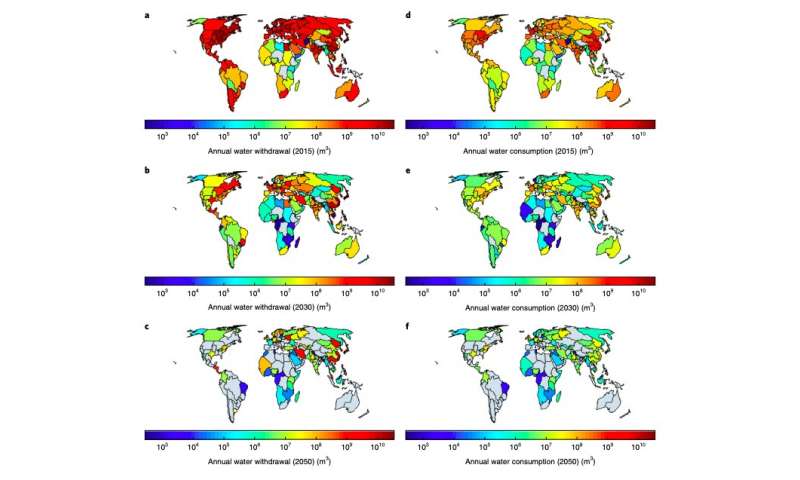Study projects scenarios for water use reduction in thermal power plants using satellite imagery
Published on by Water Network Research, Official research team of The Water Network in Academic
Image depicting water withdrawal and water consumption by thermal power plants at the regional resolution, based on the LUT Energy System Transition model and on the BPS. Credit: Lohrmann et al.
Water and energy are closely linked, as current electricity generation methods often require water, and extracting water typically consumes energy. This connection between water and energy, also known as the "water-energy nexus," has been the focus of several scientific studies.
Among other things, achieving water and energy security worldwide entails finding sustainable ways of connecting research related to the water demand of power plants with mitigation strategies for energy-based water use. Ultimately, studies that jointly investigate these two important factors could pave the way toward new solutions that ensure a more sustainable use of both water and energy.
With this in mind, a team of researchers at LUT University in Finland has recently investigated water use in thermal power plants, trying to project future scenarios for water use reduction in light of the ongoing shift toward a greener economy. In their study, featured in Nature Energy , they assessed the water footprint of a large number of thermal power plants worldwide and estimated the current water demand for power production at four different levels: globally, regionally, by country and by river.
"We linked a total of 13,863 thermal power plants with a total active capacity of 4,182 GW worldwide, which corresponds to 95.8 percent of the global thermal power plant fleet, to water bodies using the method of geographic information system (GIS) analysis, then estimated the water footprint of each of them," Alena Lohrmann, first author of the study, told Tech Xplore .
Recent research has suggested that a radical shift toward renewable energy is both technically and economically feasible. Nonetheless, whether this shift will actually take place or at what pace it will unfold is still somewhat unclear.
Essentially, Lohrmann and her colleagues wanted to carry out realistic estimations for the development of water demand that could provide valuable and reliable insight about possible future water use reduction scenarios. To achieve this, the researchers first identified the cooling technology employed at individual power plants. Subsequently, they carried out an in-depth analysis to determine seawater and freshwater demand of global thermal power plants.
The data used in their analyses was taken mainly from the GlobalData dataset, which contains information about several thousands of thermal power plants worldwide. To overcome the data limitations of the dataset, the cooling technology of each power plant was identified using satellite imagery.
Media
Taxonomy
- Energy Efficiency
- Energy Efficiency
- Thermal Storage
- Satellite
